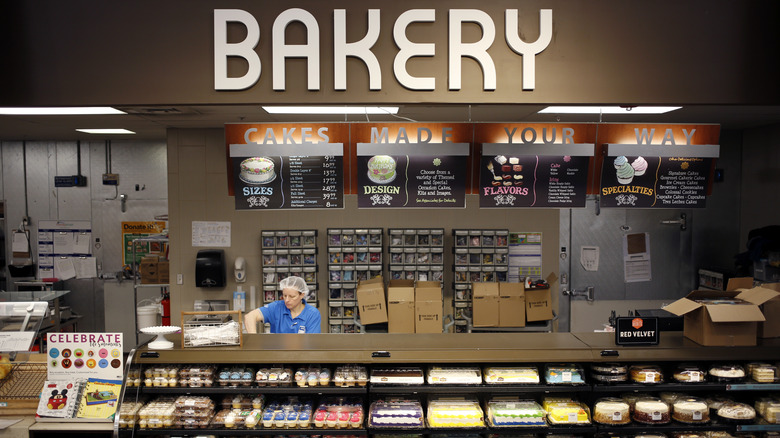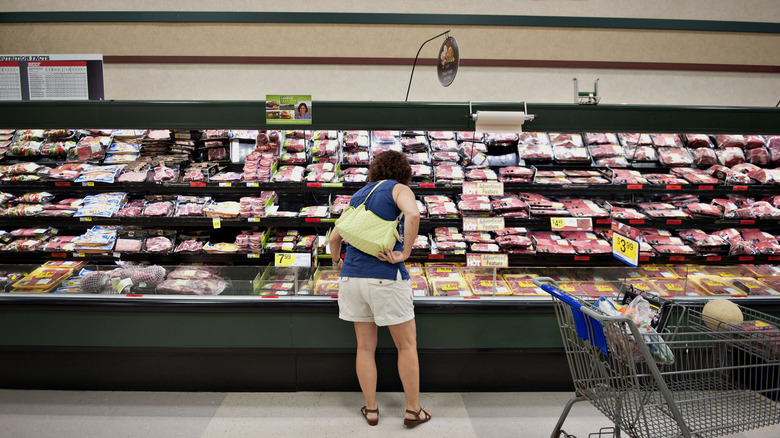Without Kroger, Grocery Stores Wouldn't Have 2 Vital Departments
As of this writing, the big box supermarket chain Kroger operates in 35 states, with over 2,700 stores, and yields $132.5 billion in sales each year, according to the company website. The founder behind today's successful grocery chain is Bernard "Barney" H. Kroger who, in 1883, invested his life savings — all of $372, which would be the equivalent of nearly $11,000 in today's money — into both his first store's location in Cincinnati and his then-unprecedented vision at the age of 24. Having made his foray into the business world as a 16-year-old tea salesman, Kroger named this store The Great Western Tea Company, per Britannica.
The company began to grow almost immediately. By 1885, Mr. Kroger already had four locations up and running, according to the same source. In 1893, there were 17 Great Western Tea stores, and that number swelled to 40 in 1902 when the grocery chain officially became the Kroger Grocery and Baking Company. Kroger continues to thrive thanks to its founder's unique vision. It's allegedly because of that very vision that grocery stores today almost uniformly have two key departments — and that might not have been the case if not, in part, for Kroger.
Supermarkets wouldn't have in-store bakeries without Kroger
All-in-one shopping is a mainstay of supermarkets, convenience stores, and warehouse clubs today (even down to the selection of Kroger's private brands, in the case of the chain today). But in 1901, Barney Kroger seemingly possessed the foresight to open bakeries in his own grocery stores, according to Britannica. As the Kroger website notes, the future chain supposedly became the first grocery store in the United States to house its own bakeries. Purportedly, the former tea salesman surmised that he could bake bread under his own grocery stores' roofs in order to save himself the money and hassle of constantly purchasing outside products from a local baker.
The choice to implement in-house bakeries allowed Mr. Kroger to do three things. First, establishing an in-store bakery made it easy for him to ensure the quality of the product his employees sold to the public. Second, it enabled Mr. Kroger to reduce costs. Third, he could then share the savings with his shoppers. It seemingly paid off: Today, there are 1,230 Kroger bakeries serving the public in 16 U.S. states. Out of those, Kroger's home state of Ohio holds the distinction of offering the most bakeries with 111 locations, according to the company's website.
Kroger's seems to be the reason why in-store meat counters are a thing
In-store bakeries were but the first step in Barney Kroger's plans to provide an all-in-one shopping experience for customers. As it stands, 1904 marked another milestone, the same year the food chain became the first grocer to house its own meat section, per Encyclopedia.com. Mr. Kroger acquired an already established business, the Nagel Meat Markets and Packing House, so that he could replicate what he'd accomplished with his in-store bakeries: An affordable, convenient all-in-one shopping experience.
However, providing a meat department proved to be more of a challenge than Mr. Kroger expected because of the unscrupulous practices committed by the butchers of the day, as certain crooked meat merchants notoriously overcharged customers by improperly weighing their products. According to the same source, after Mr. Kroger addressed the issue things, unfortunately, grew worse. Mysteriously, cash registers in the meat departments were trashed, and employees were harassed by butchers who tried to literally "freeze out" the female employees with refrigeration equipment, as well as physically intimidate the male workers. Innovation clearly wasn't easy, but Mr. Kroger's ideals won out, and today's retailers and consumers have Kroger to thank, at least in some measure, for the convenience of both bakeries and meat departments.


